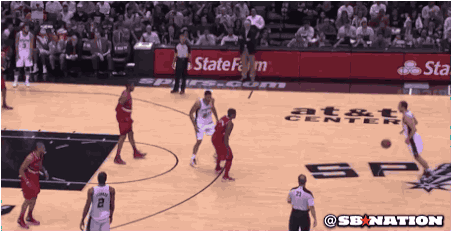The art and science of the basketball pick
The NBA Finals have started, with the San Antonio Spurs winning Game 1 over the Miami Heat after an air-conditioning fail and a wicked leg cramp took down LeBron James. (That kind of thing can happen when you play in four straight finals and an Olympics at a marathon pace.)
Meanwhile, the Spurs’ superstar Tim Duncan turned 38 during the first round of the playoffs and keeps playing at a level we haven’t seen since Kareem. He swims in the off-season, his coach rests him whenever he can, and the only muscles he seems to risk straining are when his eyes bug out every time he’s called for a foul.

It helps that Duncan’s style of play all the way since college has been preshrunk to fit an old man’s, um, let’s say, less explosive brand of athleticism. Many have even called Duncan and the Spurs “boring.” I say, maybe you just don’t know what to look for.
This isn’t a curmudgeonly rant about old-school basketball, appreciating a bank shot or the extra pass. This is about the state-of-the-art new hotness. The NBA has gotten creepily specific about crazy minutiae — floor spacing, help defense, shot selection — and both the Spurs and the Heat are the best in the world at these things. When you watch these teams, you are watching precision machines: not just the athletes and their bodies, but how all their bodies work together.
And at least one of these details — screens, or picks, i.e. Tim Duncan’s specialty — can be decently explained in terms that open up your appreciation of the game and don’t make you sound like a pedantic dick. (Also, GIFs.)
I always hear that NBA players just don’t know how to set a solid screen anymore. A lack of old-school fundamentals, they say. Damn that AAU basketball!
In reality, the nature of setting screens has changed along with the style of NBA offenses. The full-body, bone-crushing pick that frees up a jump shooter isn’t always as important as forcing the screener’s defender to make a decision that will make the other players on the defensive string also make a decision. Who helps? Who helps the helper? Do I come off that corner shooter to deal with the ball handler or roll man? It always comes back to making the defense make a decision.
To boil it down, the key part of any screen — besides, you know, putting your body in another guy’s way — is picking the angle of the screen. Get the angle right, and the other guy has to go around you the way you want him to. There are only so many angles, so there are only so many kinds of screens. They have names. And once you know what to look for, you see them everywhere on the basketball court, and the game becomes a beautiful thing.
(This is my kind of news “explainer.” Charts are great, when the data they have is good. So is history. But give me vocabulary. Help me see things better.)





Stay Connected